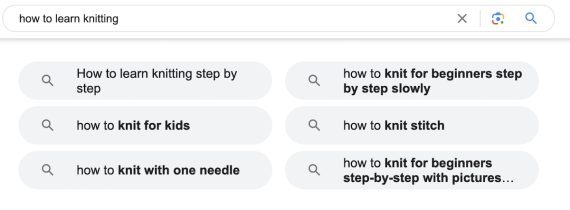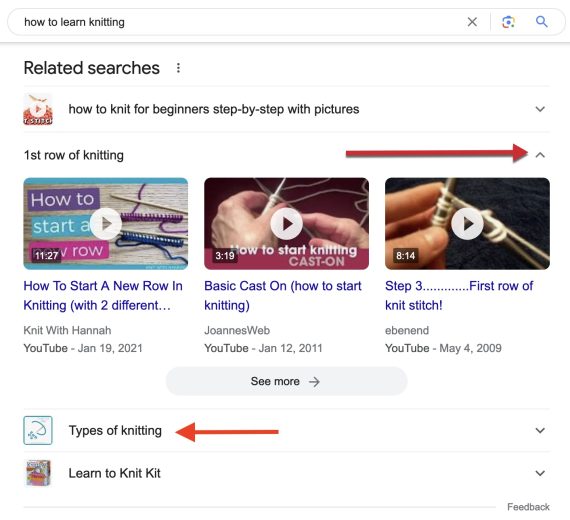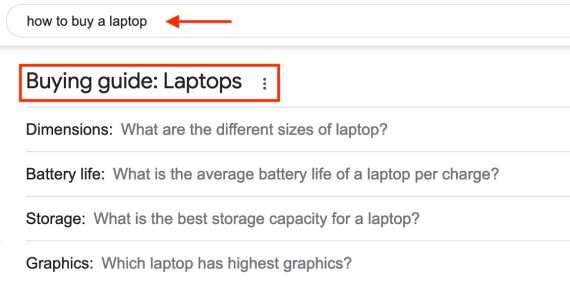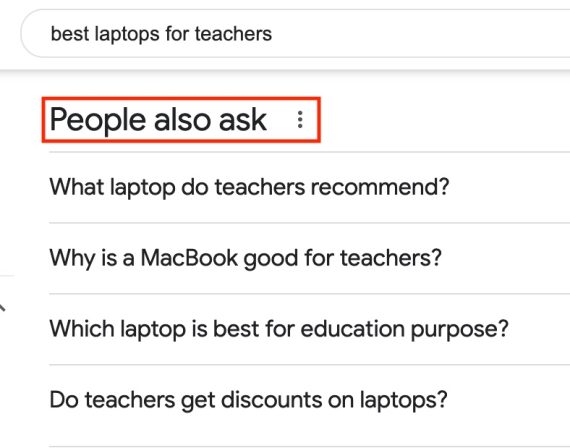Google’s search result pages provide many signals for improving organic rankings. That’s why it’s essential to actually search for each target keyword before optimizing a page or group of pages.
Keep an eye on the following sections.
Related Searches
The “Related searches” section usually resides after the first 10 or 20 results and contains phrases that produce a new set of results when clicked. The phrases are typically extended versions of the typed query but may include extraneous words.
For example, the results for “how to learn knitting” include related searches for more specific queries such as “How to knit for beginners step by step slowly” (presumably a section from a single page) and “how to knit with one needle” (likely a supporting page linking to a tutorial).
The results for “how to learn knitting” include related searches for more specific queries.
Another form of related queries is a list of topics that produce results when clicked without triggering a new search.
The same “how to learn knitting” query produces a “Related searches” section with topics such as “how to knit for beginners step-by-step with pictures” (links to video tutorials) and “Types of knitting” (different techniques).
A search for “how to learn knitting” query produces a “Related searches” section. Click image to enlarge.
Keyword Clusters
For popular queries, especially those at the start of a buying journey, Google often suggests narrowing the search based on the need. Searching “best laptops for teachers” produces the following topic clusters:
- “Under $800,”
- “Touchscreen,”
- “Under 11.6 inches,”
- “11.6 – 12.4 inches,”
- “12.4 – 14 inches.”
Searching “best laptops for teachers” will produce the topic clusters, such as “Under $800” and “Touchscreen.” Click image to enlarge.
Google likely includes the clusters based on searchers’ query and click history. The clusters help merchants plan their site architecture to assist shoppers with computer needs without returning to Google.
For some queries, Google often shows a newer “Buying guide” section, providing even more insight into the kind of content to optimize. Google’s buying guide for “how to buy a laptop” includes these sections, among others:
- “Dimensions: What are the different sizes of laptops?”
- “Battery life: What is the average battery life of a laptop per charge?”
- “Storage: What is the best storage capacity for a laptop?”
- “Graphics: Which laptop has highest graphics?”
Google often shows a newer “Buying guide” section, such as for the query “how to buy a laptop.” Click image to enlarge.
Related Questions
“People also ask” boxes reveal questions of consumers when making buying decisions. Searching “best laptops for teachers” triggers these questions:
- “What laptop do teachers recommend?”
- “Why is a MacBook good for teachers?”
- “Which laptop is best for education purposes?”
- “Do teachers get discounts on laptops?”
“People also ask” boxes reveal questions of consumers when making buying decisions. Click image to enlarge.
Clicking any question will uncover even more info. For example, clicking “Do teachers get discounts on laptops?” provides a quick answer and follow-up queries, such as:
- “Is Amazon Prime free for teachers?”
- “Does Best Buy give teacher discount for Mac?”
Engaging with “People also ask” boxes provides obvious and not-so-obvious questions to answer when optimizing a page.
Search Intent Signals
Google’s SERP sections signal its interpretation of the searcher’s intent: commercial, informational, navigational, or investigational.
- “Shopping” sections signal strong commercial intent, especially if repeated while scrolling down the page.
- Image and video packs usually signal informational intent.
- Knowledge panels, sitelinks, and same-domain results signal navigational intent and that Google recognizes the brand.
- Keyword clusters and “Buying guide” sections tend to convey investigational intent of users researching options before buying.





